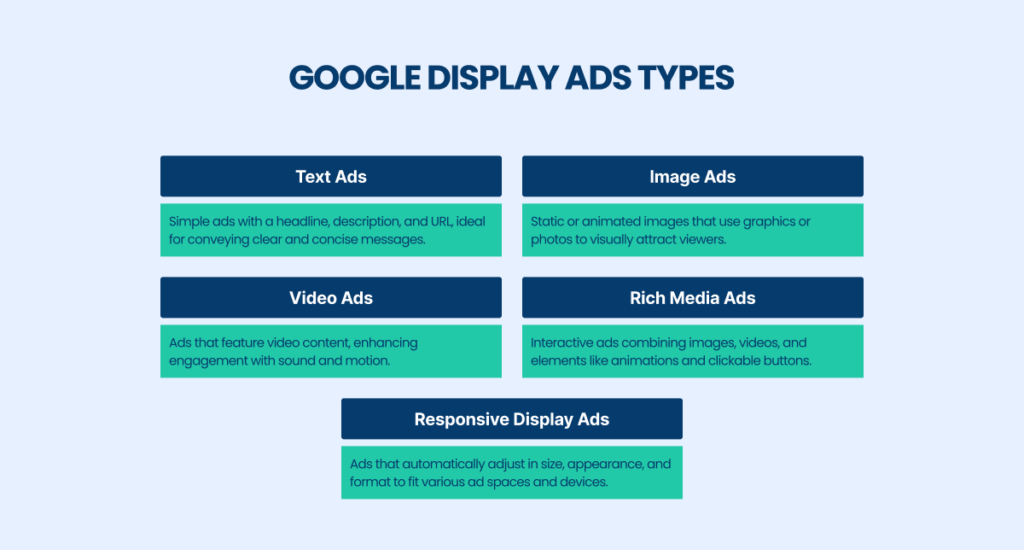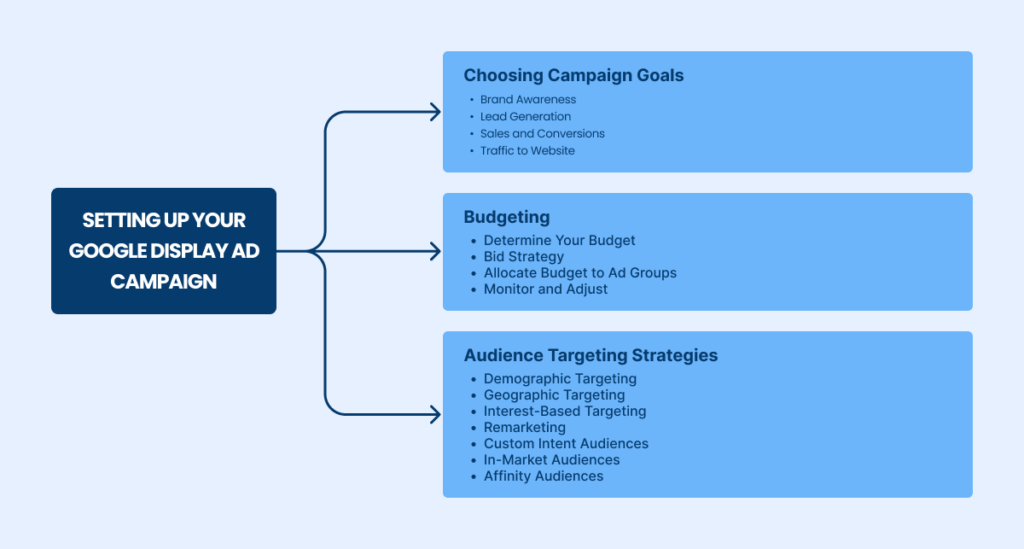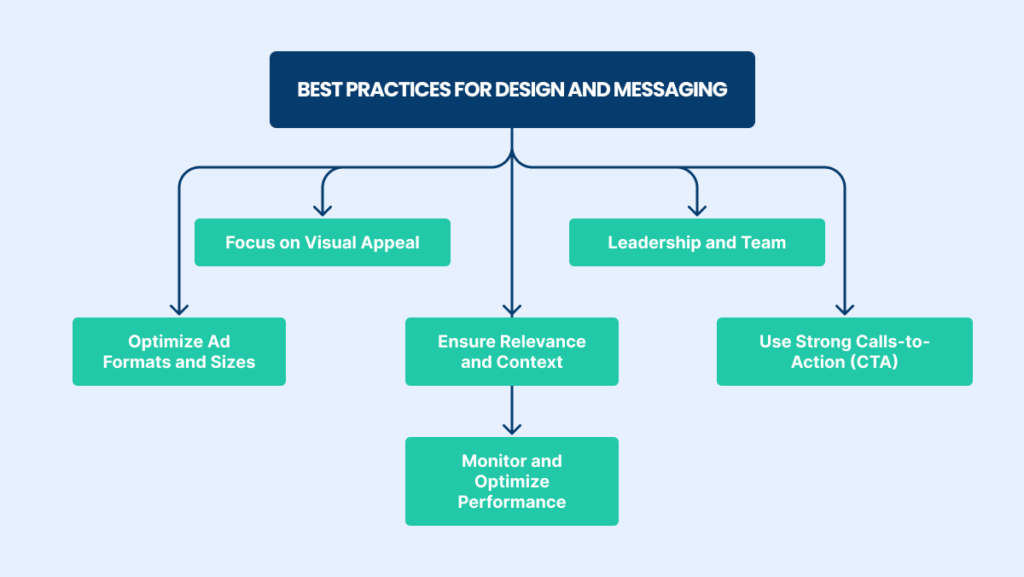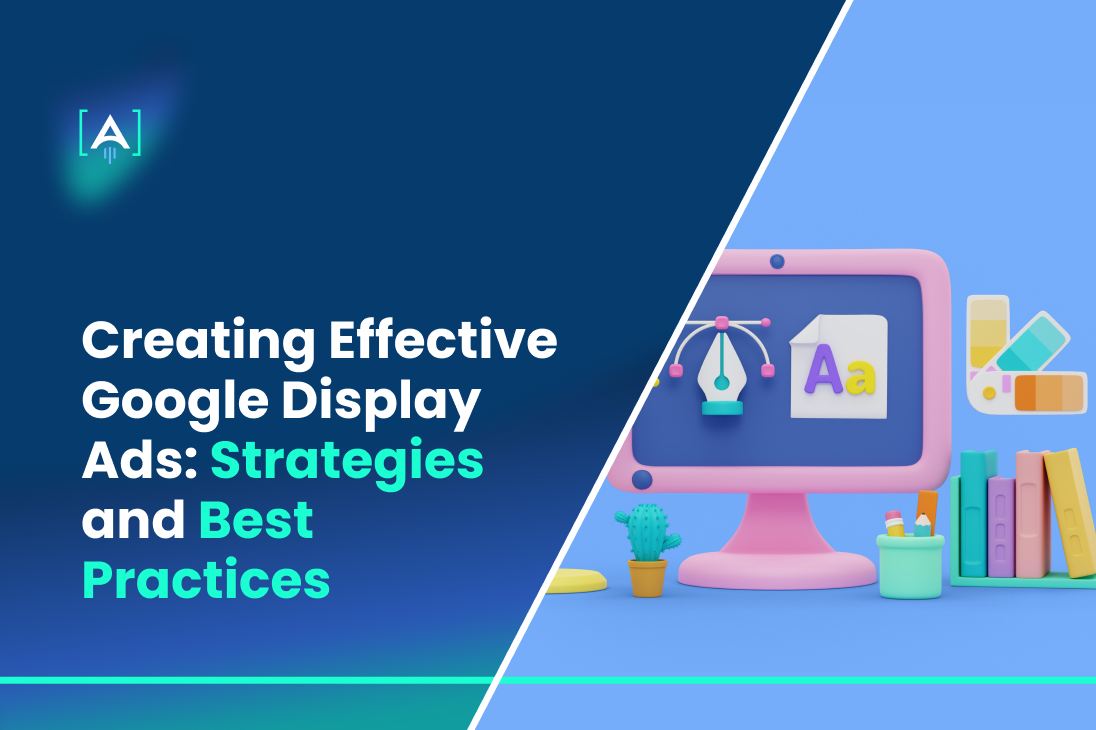How can you effectively reach a broad audience and drive engagement?
Google Display Ads are considered a powerful tool for achieving these goals.
These ads can boost brand visibility and conversion rates by leveraging the extensive reach of the Google Display Network.
Businesses leveraging display ads can see a significant increase in brand awareness, with digital ads boosting brand awareness by up to 80%.
From static image display ads to interactive multimedia, Google Display Ads has many formats that can be used to build vivid messages that genuinely connect with the target audience.
Knowing how to create them and, more importantly, how to optimize them could be a game changer for any marketing effort.
Below is an all-inclusive guide from our Google Ads Agency to help you learn the strategies and best practices for creating effective Google display ads.
Whether you’re just starting or looking to fine-tune, this piece will give you valuable insights and actionable tips.
We will also explore compelling Google Display Ads examples to illustrate how successful campaigns are structured.
Understanding Google Display Ads
When creating effective Google Display Ads, it is essential to understand the various formats and how they can be utilized to maximize engagement and conversions.
Definition and Types
Google Display Ads are advertisements displayed across the Google Display Network, a big collection of websites and apps where your ads can be displayed.
These ads are designed to capture the audience’s attention through various formats, including:
- Text Ads: Simple ads with a headline, description, and URL. These are the most basic forms of display ads, often used to convey a clear, concise message.
- Image Ads: Static or animated images that visually attract viewers. These ads can include graphics, photos, and custom designs to engage users.
- Video Ads: Ads that play video content can enhance engagement with sound and motion. These are particularly effective for storytelling and demonstrating products or services.
- Rich Media Ads: Interactive ads that combine images, videos, and other elements like animations and clickable buttons. These ads are made and designed to be engaging and can include features like expandable content and interactive games.
- Responsive Display Ads: These are ads that change in size, appearance, format, and other elements across different ad spaces. They combine text, image, and video to ensure optimal performance across various devices and platforms. Responsive display ads are versatile and ensure that your ad looks great, whether viewed on a desktop, tablet, or mobile device.
How They Work
Google Display Ads operates within the Google Display Network (GDN), which reaches over 90% of internet users globally.
When advertisers create a campaign, they start by designing the ads using the Google Ads platform.
They can choose from various formats such as text, image, video, rich media, and responsive display ads.
The next step involves selecting targeting options, including demographic information, user interests, and specific placements on websites or apps.
This will ensure that the ads reach the most relevant audience.
Once the ads and targeting options are set, the advertiser determines the bidding strategy and budget.
Google Ads uses a bidding system to decide which ads to display based on the advertiser’s bid and the quality of the ad.
When users browse websites within the Google Display Network, they encounter advertisements that can appear as banners, sidebars, or even within the content itself.
The performance of these ads can be tracked in real-time, allowing advertisers to analyze metrics like impressions, clicks, and conversions and make necessary adjustments to optimize their campaigns.

Benefits
Broad Reach: Google Display Ads provide access to millions of websites and apps, ensuring your ads can reach a vast audience. This extensive reach helps increase brand visibility and drive traffic to your site.
Targeting Options: This platform has very powerful targeting options, enabling campaigns to be really dialed in on a demographic, interest, and behavioral basis. This precision targeting ensures that ads are shown to users more likely to be interested in the product or service, enhancing ad relevance and effectiveness.
Visual Appeal: The diverse ad formats, especially image and video ads, enable businesses to create visually engaging content that captures and holds the audience’s attention. This visual appeal is crucial for developing effective display ads that stand out in a crowded digital space.
Brand Awareness: Display ads are highly effective for building brand recognition. You can significantly boost brand awareness and recall by keeping your brand visible to potential customers as they browse the web.
Cost-Effective: Compared to other forms of advertising, display ads often have a lower cost-per-click (CPC). This makes them a budget-friendly option for businesses seeking broad outreach without overspending.
Additionally, responsive display ads optimize themselves to improve performance, ensuring efficient use of the advertising budget.
Google Display Ads, combined with Google Shopping Ads, offer a comprehensive approach to driving both brand awareness and direct product sales, ensuring that your advertising efforts cover a broad spectrum of customer touchpoints.
Setting Up Your Google Display Ad Campaign
To set up an effective Google Display Ad campaign, it is essential to start with a clear understanding of your goals and budget.
Choosing Campaign Goals
Defining clear and specific goals is crucial when creating a Google Display Ad campaign. Your campaign goals will guide your strategy and help you measure success.
Common goals for display ad campaigns include:
Brand Awareness:
If your main objective is to increase brand visibility, focus on reaching a broad audience.
This goal is ideal for new product launches or businesses looking to establish a presence in the market. You can use visually appealing image ads or video ads to capture attention.
Lead Generation:
To capture leads, use tactics that encourage users to share their contact information.
This might involve offering something valuable in exchange, such as a free eBook or a discount.
Google dynamic search ads and responsive display ads can be particularly effective in these campaigns due to their adaptability and targeting capabilities.
Sales and Conversions:
If driving sales or conversions is your goal, focus on reaching users who are more likely to purchase.
Use remarketing strategies to target users who have already visited your website or shown interest in your products.
Ensure your ads have strong calls-to-action and link to landing pages optimized for conversions.
Traffic to Website:
To increase traffic to your website, create engaging ads that encourage clicks.
This can help you build an audience and channel users to your site, where you can further engage them with your content or offers.
Setting up effective Google Display Ads with compelling visuals and clear messaging will be key here.
Budgeting
Effective budgeting is essential for running successful Google Display Ad campaigns.
Here are some key considerations:
Determine Your Budget: First, plan how much money you are going to spend on your campaign.
This, of course, will depend on your marketing budget and those specific goals.
Google Ads allows daily budgets, which really help keep expenditures in check over the duration of the campaign.
Bid Strategy: Choose a bidding strategy that best suits your campaign objectives.
For example, if you’re trying to get people to become more aware of your brand, you might have a cost-per-thousand impressions bidding strategy.
A cost-per-click (CPC) or cost-per-acquisition (CPA) strategy might be more appropriate if you aim for conversions.
Google Ads offers automated bidding strategies that optimize bids based on your goals and budget.
Allocate Budget to Ad Groups: Group ads in your campaigns by ad groups. Ad groups exist to hold similar advertisements that are going after the same thing, whether it is a theme or type of audience.
For example, you can have ad groups broken out by product categories or demographic groups.
Monitor and Adjust: Regularly review your ads’ performance and adjust your budget accordingly.
Use Google Ads’ reporting tools to track key metrics such as impressions, clicks, and conversions.
This data will help you understand which ads perform well and where you might need to ramp up or pull back spend.
According to WordStream, the average small business using Google Ads spends between $9,000 and $10,000 monthly on their campaigns.
This budget can vary greatly depending on the industry and competition. It’s essential to start with a budget you are comfortable with and scale up as you see positive results.

By setting clear goals and managing your budget effectively, you can create impactful Google Display Ads that achieve your desired outcomes.
Audience Targeting Strategies
Effective targeting is the reason behind the success of any Google Display Ads.
You will be in a position to maximally stroke the bottom line of your ad impact and deliver on your campaign goals by reaching the right audience.
Here are several audience targeting strategies that help to create effective Google Display Ads
Demographic Targeting
Reach people based on age, gender, parental status, and household income with demographic targeting.
This strategy is beneficial when your product or service appeals to a specific demographic.
For example, if you are marketing a luxury product, you might target higher-income households.
Geographic Targeting
Geographic targeting involves delivering ads based on a user’s location.
This can be a country, city, or even a ZIP code. This targeting is essential for businesses that operate in particular regions or want to promote local offers.
For example, a local restaurant might target users within a 10-mile radius.
Interest-Based Targeting
Google Display Ads allow you to target users based on their interests and online behavior.
This includes users interested in specific topics or categories like fitness, travel, or technology. You can increase engagement and relevance by aligning your ads with user interests.
For example, targeting users interested in health and wellness can lead to higher interaction rates if you sell fitness equipment.
Remarketing
Google Ads Remarketing allows one to reach users who have previously visited one’s website without conversion.
This is one of the most effective ways to encourage probable customers to return and complete a purchase.
You can remind users about your products and offers through timely, relevant ads as they visit other websites.
With Google Ads remarketing, you would be able to promote higher conversion rates and improve your ROI.
Custom Intent Audiences
Custom intent audiences allow you to create a tailored audience based on specific keywords and URLs related to your business.
This targeting option is beneficial for reaching users who are actively looking for products or services like yours.
For example, if you sell eco-friendly products, you could create a custom intent audience based on keywords like “sustainable living” and “green products.”
In-Market Audiences
In-market audiences consist of users actively considering purchasing a product or service similar to yours.
Google identifies these users based on their online behavior and searches lately.
This targeting method is particularly effective for driving conversions, as it reaches users close to making a purchase decision.
Affinity Audiences
Affinity audiences include users with a strong interest in a particular topic.
These audiences are grouped based on their long-term interests, such as sports, travel, or cooking.
Targeting affinity audiences can help you reach a broader but relevant audience for your display ads.
By implementing these audience targeting strategies, you can create effective Google Display Ads that resonate with your target audience and drive meaningful results.
Crafting Compelling Ad Creatives
Creating a working Google Display Ads involves crafting ad creatives that are visually appealing, engaging, and compelling.
Before discussing specific elements, it’s crucial to understand that the goal of your ad creative is to capture attention quickly and drive action.
This requires balancing visual appeal, clear messaging, and strategic calls to action.
Here are some essential elements to focus on to make your display ad campaigns successful.
Visual Elements
Your visual elements are the first thing viewers will notice about your Google Display Ads. High-quality and relevant visuals can significantly impact your ad’s effectiveness.
Consider the following aspects:
- High-Quality Images: Use high-resolution images that are clear and relevant to your product or service. Avoid using generic stock photos that may not resonate with your audience.
- Brand Colors and Logo: Incorporate your brand’s colors and logo to ensure brand consistency and recognition across all your ads.
- Readable Fonts: Choose easy to read across different devices and screen sizes. Avoid overly decorative fonts that might be difficult to decipher.
- Contrast and Layout: Ensure enough contrast between text and background to enhance readability. Use a clean and uncluttered layout to focus attention on the main message.
- Video Content: If using video ads, ensure they are professionally produced and concise, capturing the viewer’s attention within the first few seconds.
Ad Copywriting
The copy in your Google Display Ads should be clear, concise, and compelling. Begin with an eye-catching headline that relates to the big benefit your product or service offers.
Follow this with a brief description elaborating on the headline, detailing more, and encouraging the viewer to act. The copy should avoid jargon and use simple, direct language.
After all, your view is probably only going to give your ad a few seconds at most.
The ad copy should clearly and concisely communicate to the target audience their needs and preferences.
Focus on what makes the product special and different from any other product available in the market.
These strong words, through their effects, should start an action. The tone of voice should be with reference to your brand.
According to HubSpot, ads with clear and compelling headlines can have an 18% higher click-through rate.
Call-to-Action (CTA)
A strong call-to-action (CTA) drives user engagement and conversions. Your CTA should be clear, direct, and aligned with your campaign goals.
Phrases like “Shop Now,” “Learn More,” “Sign Up,” or “Get Started” can be effective.
The CTA should stand out visually, using contrasting colors or buttons to draw attention.
Additionally, ensure the landing page linked to your CTA is relevant and provides a seamless transition from the ad, enhancing the user experience and increasing the likelihood of conversions.
To make your CTA even more compelling, consider offering a motive, such as a discount, free trial, or exclusive content.
This can create a sense of urgency and motivate users to act quickly. Also, use action-oriented language that tells users exactly what to do next, such as “Download Your Free Guide” or “Claim Your Discount.”
Ad Sizes and Formats
Using suitable ad sizes and formats can enhance the visibility and effectiveness of your Google Display Ads.
Google recommends several standard sizes that perform well across different placements:
- Standard Sizes: Use the standard ad sizes recommended by Google, such as 300×250 (Medium Rectangle), 336×280 (large rectangle), 728×90 (Leaderboard), and 160×600 (Wide Skyscraper). These sizes are widely supported and perform well across different placements.
- Responsive Ads: Utilize responsive display ads that automatically modify their size, look, and format to fit available ad spaces. This flexibility ensures that your ads look great on any device and reach a broader audience.
- Rich Media Ads: Consider using rich media ads with interactive elements like animations, sliders, or expandable content. These ads can increase engagement by providing a more immersive experience.
- Video Ads: Incorporate video ads into your display ad campaigns for a more dynamic approach. Ensure videos are short and engaging and convey your message right away within the first few seconds.
Focus on these elements to get on the road to rich display ads that get noticed and are full of good reactions and conversions.

To get inspired further, look through successful examples of Google Display Ads to realize what works and what doesn’t in different scenarios.
A Google display ad will effectively resonate with the target audience and meet the campaign goals if the ad can be based on a strategic approach in terms of visual conception, ad copy, and targeting.
Google Display Ads Real Examples: Analyzing Effective Campaigns
To truly understand what makes a Google Display Ad effective, let’s look at some real-world examples from well-known brands. These examples illustrate key strategies that can be applied to your campaigns.
1. Apple Gift Card Ad
Source:Apple
Analysis:
Apple’s ad promoting Apple gift cards is a masterclass in minimalistic yet colorful design. The ad likely features sleek, high-quality visuals of Apple Gift card, combined with a simple yet powerful headline like “The gift card for everything Apple.” The CTA “Shop” is clear and action-oriented, driving users to explore gift options.
Key Elements:
- Minimalist Design: Apple’s signature minimalist design ensures that the ad is clean and free of clutter, focusing solely on the product.
- High-Quality Imagery: The use of high-resolution images enhances the premium feel of the brand. The ad focuses on visually appealing elements, such as colorful gift cards, to engage viewers.
- Direct CTA: The CTA is straightforward, guiding the viewer to make a purchase decision.
- Brand Consistency: The ad’s design and messaging are consistent with Apple’s overall brand identity, reinforcing brand recognition.
2. Nike SNKRS Showcase Ad
Source:Nike
Analysis:
Nike’s SNKRS Showcase ad is visually dynamic, featuring bold imagery of their latest sneaker launch. The headline might say something like “Step Into the Future of Footwear,” paired with a CTA like “Explore Now.” The ad uses high-contrast colors and motion to capture attention and convey a sense of excitement around the product launch.
Key Elements:
- Bold Visuals: Nike uses strong, eye-catching imagery to showcase their product, aligning with the brand’s dynamic and energetic image.
- Engaging Headline: The headline creates a sense of anticipation and innovation, which is core to Nike’s brand messaging.
- High-Contrast Design: The use of vibrant colors and contrast draws the viewer’s eye, making the ad stand out.
- Interactive CTA: The CTA encourages users to engage with the product, driving them to explore the new sneaker line.
3. Disney+ Free Trial Banner
Source: Disney+
Analysis:
Disney+ promotes its free trial with a visually rich banner featuring popular characters like Iron Man, Moana, Star Wars icons, and the Incredibles. The headline might be “Start Your Free Trial Today,” and the CTA “Sign Up Now” is positioned prominently. The ad’s design is vibrant and full of color, appealing to a broad audience of all ages.
Key Elements:
- Character Appeal: Featuring beloved characters immediately connects with a wide range of viewers, leveraging familiarity and nostalgia.
- Vibrant Design: The use of bright colors and familiar faces makes the ad visually appealing and memorable.
- Clear Value Proposition: The offer of a free trial is prominently displayed, making it an attractive proposition for potential subscribers.
- Prominent CTA: The CTA is clear and action-oriented, encouraging immediate sign-ups.
Take Your Google Display Ads to the Next Level with Azarian Growth Agency
Whether aiming to increase brand awareness, drive traffic, generate leads, or boost sales, Google Display Ads offer a versatile and powerful platform to reach your goals.
For those looking to elevate their advertising efforts, partnering with a professional Google Ads Agency can provide the expertise and support needed to maximize results.
At Azarian Growth Agency, we specialize in managing and optimizing Google Display Ad campaigns to help businesses grow.
Our team of professionals will work with you to make customized strategies that align with your goals and deliver measurable outcomes.
Contact us now and Get Your Free Marketing Plan

